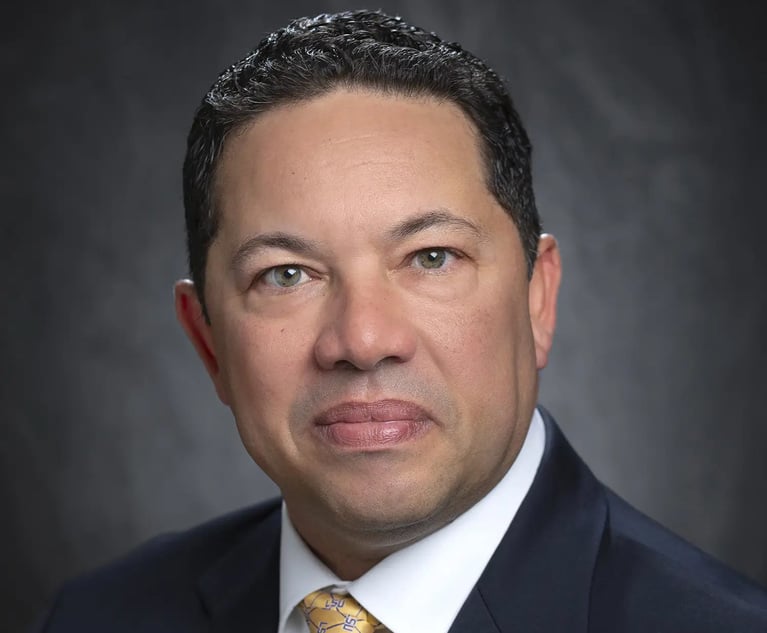Four steps to building trust in the C-suite and beyond
When trust is present, information will flow more readily, others will be more receptive to your guidance and you will receive more honest feedback.
October 31, 2014 at 08:00 PM
7 minute read
Trust is the foundation of successful relationships. As I prepared the series “Directions to the GC Chair,” trust emerged as the prevailing theme in developing relationships with board members and colleagues in the C-suite. When trust is present, information will flow more readily, others will be more receptive to your guidance and you will receive more honest feedback.
Developing trust is not difficult. One of my early coaching clients and colleagues is Charles H. Green, co-author of “The Trusted Advisor” and author of “The Trusted Advisor Field Book,” along with numerous articles and blogs. While trust is often an emotional response, in “The Trusted Advisor,” the authors share a formula (the Trust Equation) for people to create and maintain trust. In the Trust Equation, “T” is trustworthiness; the other elements are defined below:
Trustworthiness = (Credibility + Reliability + Intimacy)/Self-Orientation
Credibility: We build credibility via our credentials and experience. For a general counsel or aspiring GC, examples include executive presence, solid business judgment, financial acumen and success at key positions. Also, you can demonstrate credibility by taking a lead role on a major acquisition, answering questions directly and giving your opinion succinctly.
Reliability: You can prove to the C-suite and board that they can count on you when you:
-
Make and keep commitments. If you can't keep a commitment, let others know right away.
-
Respond promptly to calls and emails.
-
Show consistency in your actions and attitudes.
Intimacy: Green and his co-authors use this word to mean connectedness, empathy and discretion. Intimacy can engender relationships where board members and colleagues in the C-suite share what is most important to them. You may hear their fears, career plans and relationship issues. Green also suggests ways to increase intimacy:
-
Show you are discreet. Treat conversations with each individual as confidential and let them know that you are doing so.
-
Don't listen to gossip—and don't gossip yourself.
-
Listen empathetically and deeply to more than the words themselves. Pay attention to tone and body language. If the words, body language or tone do not match, ask discreetly about it. Green says that listening earns you the right to give advice.
Self-Orientation: This element of the Trust Equation, being the denominator, works in reverse. It is about your focus. To trust you in business, people need to believe that you are motivated by the best interests of the company and employees. That means being unselfish, but it also means being calm, not preoccupied and self-secure. These qualities help you to be perceived as objective without raising questions as to whether you have a personal agenda. Here are some simple—yet essential—things to do:
-
While Green acknowledges the importance of preparation, it is equally important to demonstrate agility and flexibility, to listen and to adapt to the flow of conversation.
-
Don't hesitate to voice your opinion because you are concerned it won't be popular. Yes, you have to pick your fights, but when you hold back because of how you might look, that's about you and increases your self-orientation.
-
On the other hand, don't be overly vested in your solution.
-
When someone expresses an idea with which you agree, give credit where it is due.
Green also notes that the Trust Equation is only one side of the trust dynamic—the side of trustworthiness, the one being trusted. There is another side: The person doing the trusting and taking the risks. It may be obvious that others take risks in trusting us. It is less obvious that we have to show that we trust them as well. Try applying the Trust Equation to all your relationships, not just those in the C-suite. You might be pleasantly surprised.
Trust is the foundation of successful relationships. As I prepared the series “Directions to the GC Chair,” trust emerged as the prevailing theme in developing relationships with board members and colleagues in the C-suite. When trust is present, information will flow more readily, others will be more receptive to your guidance and you will receive more honest feedback.
Developing trust is not difficult. One of my early coaching clients and colleagues is Charles H. Green, co-author of “The Trusted Advisor” and author of “The Trusted Advisor Field Book,” along with numerous articles and blogs. While trust is often an emotional response, in “The Trusted Advisor,” the authors share a formula (the Trust Equation) for people to create and maintain trust. In the Trust Equation, “T” is trustworthiness; the other elements are defined below:
Trustworthiness = (Credibility + Reliability + Intimacy)/Self-Orientation
Credibility: We build credibility via our credentials and experience. For a general counsel or aspiring GC, examples include executive presence, solid business judgment, financial acumen and success at key positions. Also, you can demonstrate credibility by taking a lead role on a major acquisition, answering questions directly and giving your opinion succinctly.
Reliability: You can prove to the C-suite and board that they can count on you when you:
-
Make and keep commitments. If you can't keep a commitment, let others know right away.
-
Respond promptly to calls and emails.
-
Show consistency in your actions and attitudes.
Intimacy: Green and his co-authors use this word to mean connectedness, empathy and discretion. Intimacy can engender relationships where board members and colleagues in the C-suite share what is most important to them. You may hear their fears, career plans and relationship issues. Green also suggests ways to increase intimacy:
-
Show you are discreet. Treat conversations with each individual as confidential and let them know that you are doing so.
-
Don't listen to gossip—and don't gossip yourself.
-
Listen empathetically and deeply to more than the words themselves. Pay attention to tone and body language. If the words, body language or tone do not match, ask discreetly about it. Green says that listening earns you the right to give advice.
Self-Orientation: This element of the Trust Equation, being the denominator, works in reverse. It is about your focus. To trust you in business, people need to believe that you are motivated by the best interests of the company and employees. That means being unselfish, but it also means being calm, not preoccupied and self-secure. These qualities help you to be perceived as objective without raising questions as to whether you have a personal agenda. Here are some simple—yet essential—things to do:
-
While Green acknowledges the importance of preparation, it is equally important to demonstrate agility and flexibility, to listen and to adapt to the flow of conversation.
-
Don't hesitate to voice your opinion because you are concerned it won't be popular. Yes, you have to pick your fights, but when you hold back because of how you might look, that's about you and increases your self-orientation.
-
On the other hand, don't be overly vested in your solution.
-
When someone expresses an idea with which you agree, give credit where it is due.
Green also notes that the Trust Equation is only one side of the trust dynamic—the side of trustworthiness, the one being trusted. There is another side: The person doing the trusting and taking the risks. It may be obvious that others take risks in trusting us. It is less obvious that we have to show that we trust them as well. Try applying the Trust Equation to all your relationships, not just those in the C-suite. You might be pleasantly surprised.
This content has been archived. It is available through our partners, LexisNexis® and Bloomberg Law.
To view this content, please continue to their sites.
Not a Lexis Subscriber?
Subscribe Now
Not a Bloomberg Law Subscriber?
Subscribe Now
NOT FOR REPRINT
© 2025 ALM Global, LLC, All Rights Reserved. Request academic re-use from www.copyright.com. All other uses, submit a request to [email protected]. For more information visit Asset & Logo Licensing.
You Might Like
View All
LSU General Counsel Quits Amid Fracas Over First Amendment Rights of Law Professor
7 minute read
Exits Leave American Airlines, SiriusXM, Spotify Searching for New Legal Chiefs
2 minute read
'A Warning Shot to Board Rooms': DOJ Decision to Fight $14B Tech Merger May Be Bad Omen for Industry
Trending Stories
- 1Veritext Legal Solutions Announces the Past Acquisitions of Three Alternative Dispute Resolution Firms
- 2Sarno da Costa D’Aniello Maceri LLC Announces Addition of New Office in Eatontown, NJ, and Named Partner
- 3LSU General Counsel Quits Amid Fracas Over First Amendment Rights of Law Professor
- 4An Eye on ‘De-Risking’: Chewing on Hot Topics in Litigation Funding With Jeffery Lula of GLS Capital
- 5Arguing Class Actions: With Friends Like These...
Who Got The Work
J. Brugh Lower of Gibbons has entered an appearance for industrial equipment supplier Devco Corporation in a pending trademark infringement lawsuit. The suit, accusing the defendant of selling knock-off Graco products, was filed Dec. 18 in New Jersey District Court by Rivkin Radler on behalf of Graco Inc. and Graco Minnesota. The case, assigned to U.S. District Judge Zahid N. Quraishi, is 3:24-cv-11294, Graco Inc. et al v. Devco Corporation.
Who Got The Work
Rebecca Maller-Stein and Kent A. Yalowitz of Arnold & Porter Kaye Scholer have entered their appearances for Hanaco Venture Capital and its executives, Lior Prosor and David Frankel, in a pending securities lawsuit. The action, filed on Dec. 24 in New York Southern District Court by Zell, Aron & Co. on behalf of Goldeneye Advisors, accuses the defendants of negligently and fraudulently managing the plaintiff's $1 million investment. The case, assigned to U.S. District Judge Vernon S. Broderick, is 1:24-cv-09918, Goldeneye Advisors, LLC v. Hanaco Venture Capital, Ltd. et al.
Who Got The Work
Attorneys from A&O Shearman has stepped in as defense counsel for Toronto-Dominion Bank and other defendants in a pending securities class action. The suit, filed Dec. 11 in New York Southern District Court by Bleichmar Fonti & Auld, accuses the defendants of concealing the bank's 'pervasive' deficiencies in regards to its compliance with the Bank Secrecy Act and the quality of its anti-money laundering controls. The case, assigned to U.S. District Judge Arun Subramanian, is 1:24-cv-09445, Gonzalez v. The Toronto-Dominion Bank et al.
Who Got The Work
Crown Castle International, a Pennsylvania company providing shared communications infrastructure, has turned to Luke D. Wolf of Gordon Rees Scully Mansukhani to fend off a pending breach-of-contract lawsuit. The court action, filed Nov. 25 in Michigan Eastern District Court by Hooper Hathaway PC on behalf of The Town Residences LLC, accuses Crown Castle of failing to transfer approximately $30,000 in utility payments from T-Mobile in breach of a roof-top lease and assignment agreement. The case, assigned to U.S. District Judge Susan K. Declercq, is 2:24-cv-13131, The Town Residences LLC v. T-Mobile US, Inc. et al.
Who Got The Work
Wilfred P. Coronato and Daniel M. Schwartz of McCarter & English have stepped in as defense counsel to Electrolux Home Products Inc. in a pending product liability lawsuit. The court action, filed Nov. 26 in New York Eastern District Court by Poulos Lopiccolo PC and Nagel Rice LLP on behalf of David Stern, alleges that the defendant's refrigerators’ drawers and shelving repeatedly break and fall apart within months after purchase. The case, assigned to U.S. District Judge Joan M. Azrack, is 2:24-cv-08204, Stern v. Electrolux Home Products, Inc.
Featured Firms
Law Offices of Gary Martin Hays & Associates, P.C.
(470) 294-1674
Law Offices of Mark E. Salomone
(857) 444-6468
Smith & Hassler
(713) 739-1250







